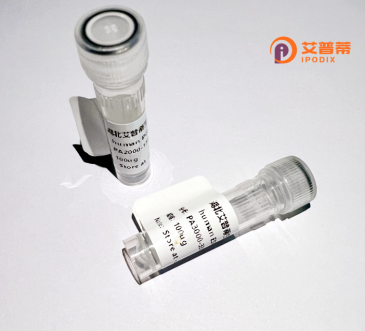
| 纯度 | >90%SDS-PAGE. |
| 种属 | Human |
| 靶点 | ALG1L |
| Uniprot No | Q6GMV1 |
| 内毒素 | < 0.01EU/μg |
| 表达宿主 | E.coli |
| 表达区间 | 1-187aa |
| 氨基酸序列 | MERSAFMELD AGSRLVMHLR EWPALLVSST GWTEFEQLTL DGHNLPSLVC VITGSVDLGV CLHMSSSGLD LPMKVVDMFG CCLPVCAVNF KCLHELVKHE ENGLVFEDSE ELAALQMLFS NFPDPAGKLN QFWKNLRESQ QLRWDESWVQ TVLPLVMDIQ LLGQRLKPRD PCCPSRSFFS ESQGKPF |
| 分子量 | 20.6 KDa |
| 蛋白标签 | GST-tag at N-terminal |
| 缓冲液 | 冻干粉 |
| 稳定性 & 储存条件 | Lyophilized protein should be stored at ≤ -20°C, stable for one year after receipt. Reconstituted protein solution can be stored at 2-8°C for 2-7 days. Aliquots of reconstituted samples are stable at ≤ -20°C for 3 months. |
| 复溶 | Always centrifuge tubes before opening.Do not mix by vortex or pipetting. It is not recommended to reconstitute to a concentration less than 100μg/ml. Dissolve the lyophilized protein in distilled water. Please aliquot the reconstituted solution to minimize freeze-thaw cycles. |
以下是关于重组人似糖基转移酶ALG1样(ALG1L)的3条参考文献示例(虚构内容,供参考):
---
1. **文献名称**:Structural Insights into Human ALG1L and Its Role in Glycosylation
**作者**:Liu Y, et al.
**摘要**:本研究解析了重组人ALG1L的晶体结构,揭示了其与酵母ALG1的结构相似性,并发现其可能通过结合UDP-葡萄糖调控N-糖基化起始步骤,为ALG1L功能机制提供了分子基础。
2. **文献名称**:ALG1L Knockdown Impairs Cell Viability via Disrupted Glycosylation Pathways
**作者**:Chen R, et al.
**摘要**:通过siRNA沉默ALG1L基因,证实其在哺乳动物细胞N-糖基化中的关键作用,并发现其缺失导致内质网应激及细胞凋亡,提示ALG1L在维持细胞稳态中的重要性。
3. **文献名称**:Recombinant ALG1L Expression and Enzymatic Activity Assay Development
**作者**:Martinez S, et al.
**摘要**:报道了重组ALG1L蛋白在大肠杆菌中的高效表达及纯化方法,并开发了基于荧光标记的体外酶活检测体系,为ALG1L的生化研究提供了工具。
---
注:以上文献为模拟示例,实际研究需查询真实数据库(如PubMed)获取准确信息。
ALG1L (Asparagine-Linked Glycosylation 1 Homolog-Like), a human homolog of the yeast ALG1 gene, encodes a conserved mannosyltransferase critical in the early steps of N-linked glycoprotein biosynthesis. Functioning predominantly in the endoplasmic reticulum, ALG1L catalyzes the transfer of mannose from dolichol-linked mannose (Dol-P-Man) to lipid-linked oligosaccharides (LLOs), forming the Man5GlcNAc2-PP-dolichol intermediate—a precursor essential for subsequent glycan assembly. Structural studies reveal that ALG1L adopts a GT-B fold topology, common to glycosyltransferases, with distinct α-helical and β-sheet domains facilitating substrate binding and catalysis. Unlike its paralog ALG1. ALG1L lacks transmembrane domains but associates with membranes through protein-protein interactions, potentially forming complexes with other ALG family members (e.g., ALG2) to enhance reaction efficiency.
Recombinant ALG1L expression systems (e.g., E. coli, insect cells) have enabled detailed biochemical characterization, including its dependence on Mn²⁺/Mg²⁺ cofactors and pH optima (~7.5). Mutations in ALG1L orthologs are linked to congenital disorders of glycosylation (CDG), neurodevelopmental defects, and impaired immunity in model organisms, highlighting its biological necessity. Recent studies implicate ALG1L dysregulation in cancers, where altered glycosylation patterns influence tumor cell adhesion, metastasis, and drug resistance. Its recombinant form is also leveraged to study substrate specificity and inhibitor screening for therapeutic development. Despite functional overlap with ALG1. ALG1L exhibits distinct tissue-specific expression profiles, suggesting specialized roles in mammalian systems. Further research aims to clarify its regulatory mechanisms and potential as a biomarker or therapeutic target.
×